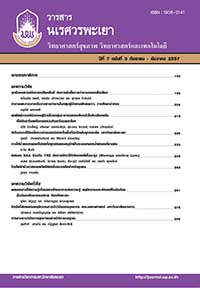ผลลัพธ์ทางคลินิกของผู้ป่วยไทยกลุ่มอาการหลอดเลือดหัวใจตีบเฉียบพลันที่ได้รับยาโคลพิโดเกรลร่วมกับยาโอเมพราโซล
Keywords:
โคลพิโดเกรล, โอเมพราโซล, อันตรกิริยาระหว่างยา, หลอดเลือดหัวใจตีบเฉียบพลัน, เอนไซม์ CYP2C19, Clopidogrel, omeprazole, drug interaction, acute coronary syndrome, CYP2C19Abstract
ความชุกของประชากรไทยที่มีการทำงานของเอนไซม์ CYP2C19 บกพร่อง พบมากกว่าประชากรบางเชื้อชาติจากการศึกษาก่อนหน้านี้ ซึ่งอาจส่งผลต่ออันตรกิริยาระหว่างยาโคลพิโดเกรลและยาโอเมพราโซลในผู้ป่วยไทยซึ่งยังไม่มีข้อมูลที่ชัดเจน วัตถุประสงค์ของการศึกษานี้คือเปรียบเทียบผลลัพธ์ทางคลินิกของผู้ป่วยไทยกลุ่มอาการหลอดเลือดหัวใจตีบเฉียบพลันที่ได้รับยาโคลพิโดเกรลร่วมกับยาโอเมพราโซล กับผู้ป่วยที่ไม่ได้รับยาโอเมพราโซล โดยเป็นการวิจัยเชิงวิเคราะห์แบบย้อนหลังในผู้ป่วยโรคหลอดเลือดหัวใจตีบเฉียบพลัน จำนวน 839 ราย ที่ได้รับยาโคลพิโดเกรลขณะออกจากโรงพยาบาลมหาราชนครเชียงใหม่ ระหว่างวันที่ 1 มกราคม พ.ศ. 2549 ถึงวันที่ 31 ธันวาคม พ.ศ. 2553 โดยผลลัพธ์หลักคือผลรวมของอัตราการตายจากทุกสาเหตุหรือการกลับเข้ามารักษาในโรงพยาบาลเพื่อทำหัตถการเปิดหลอดเลือดหัวใจที่อุดตัน ในผู้ป่วยทั้งหมด 839 ราย พบว่าร้อยละ 46.0 ได้รับยาโคลพิโดเกรลร่วมกับยาโอเมพราโซลและร้อยละ 54.0 ไม่ได้รับยาโอเมพราโซล ผู้ป่วยส่วนใหญ่ประมาณร้อยละ 98 ในทั้งสองกลุ่มได้รับยาแอสไพรินร่วมด้วย จากการวิเคราะห์แบบ univariable logistic regression แสดงให้เห็นว่ากลุ่มผู้ป่วยที่ได้รับยาโอเมพราโซลมีอุบัติการณ์การตายจากทุกสาเหตุหรือการกลับเข้ามารักษาในโรงพยาบาลเพื่อทำหัตถการเปิดหลอดเลือดหัวใจที่อุดตันไม่แตกต่างกับกลุ่มผู้ป่วยที่ไม่ได้รับยาโอเมพราโซล (ร้อยละ 22.5 และ ร้อยละ 26.0 ตามลำดับ, p=0.963) และไม่พบความแตกต่างกันของผลลัพธ์รองอันได้แก่การตายจากทุกสาเหตุ (p-value=0.950) และการกลับเข้ามารักษาในโรงพยาบาลเพื่อทำหัตถการเปิดหลอดเลือดหัวใจที่อุดตัน (p-value=0.206) ระหว่างผู้ป่วยที่ได้รับยาโอเมพราโซลและผู้ป่วยที่ไม่ได้รับยาโอเมพราโซล จากการวิเคราะห์แบบ multivariable cox-proportional hazard แสดงให้เห็นว่าการรับยาโอเมพราโซลไม่มีความสัมพันธ์กับการเพิ่มความเสี่ยงของการตายจากทุกสาเหตุหรือการกลับเข้ามารักษาในโรงพยาบาลเพื่อทำหัตถการเปิดหลอดเลือดหัวใจที่อุดตัน (adjusted hazard ratio 1.00; 95%CI, 0.75-1.32) โดยสอดคล้องกับการวิเคราะห์ Kaplan-Meier curves ที่พบว่าระยะเวลาปลอดเหตุการณ์จากการตายทุกสาเหตุหรือการกลับเข้ามารักษาในโรงพยาบาลเพื่อทำหัตถการเปิดหลอดเลือดหัวใจที่อุดตันระหว่างสองกลุ่มไม่แตกต่างกันอย่างมีนัยสำคัญทางสถิติ (log rank test, p-value=0.919) ผลจากการศึกษานี้แสดงให้เห็นว่าในผู้ป่วยไทยกลุ่มอาการหลอดเลือดหัวใจตีบเฉียบพลันที่ได้รับยาโคลพิโดเกรลร่วมกับยาโอเมพราโซลไม่มีผลทำให้เหตุการณ์ไม่พึงประสงค์ต่อระบบหัวใจและหลอดเลือดเพิ่มขึ้น
Clinical outcomes of Thai patients with acute coronary syndrome receiving clopidogrel concomitant with omeprazole
Niwat Uantyai1*, Arintaya Phromintikul2, Surarong Chinwong3, Kanokporn Niwatananun3
1 Pharmacy department, Maechai hospital, Phayao Province 56130
2 Division of Cardiology, Department of Internal Medicine, Faculty of Medicine, 3 Pharmaceutical Care Department, Faculty of Pharmacy, Chiangmai University, Chiangmai Province 50200
The prevalence of CYP2C19 poor metabolizer in Thais is much greater than among other populations in previous studies that may result in clinical significance of drug interactions between clopidogrel and omeprazole. In Thai patients, there was still lack of information regarding the interaction between these two drugs. The objective of this study was to compare clinical outcomes of Thai patients with acute coronary syndrome (ACS) receiving clopidogrel concomitant with omeprazole and without omeprazole. Analytical retrospective cohort study consisting of 839 patients with ACS taking clopidogrel after discharge between January 1, 2006 and December 31, 2010 from Maharaj Nakorn Chiangmai Hospital was carried out. The primary outcome was the combined end point of all-cause mortality or rehospitalization for revascularization. Among 839 patients, 46.0% (n=386) received clopidogrel with omeprazole and 54.0 % (n=453) did not received omeprazole. Most patients in both groups, about 98 percent received aspirin. Univariable logistic regression analysis showed that the patients receiving omeprazole had similar incidence rate of combined all-cause mortality or rehospitalization for revascularization compared to those without omeprazole use (22.5% and 26.0 %, respectively, p=0.963) and there were comparable of secondary outcomes, all-cause mortality (p-value=0.950) and rehospitalization for revascularization (p-value=0.206) between the patients with concomitant use of omeprazole and those without omeprazole. From multivariable cox-proportional hazard analyses, receiving omeprazole was not associated with an increased risk of all-cause mortality or rehospitalization for revascularization (adjusted hazard ratio 1.00; 95%CI, 0.75-1.32). Additionally, Kaplan-Meier curves analysis showed that time to events of all-cause mortality or rehospitalization for revascularization in both groups were comparable, there is statistically significant difference (log rank test, p-value=0.919). The results of this study suggest that Thai patients with ACS receiving clopidogrel concomitant with omeprazole were not associated with increased rate of adverse cardiovascular events.Downloads
Published
How to Cite
Issue
Section
License
ผู้นิพนธ์ต้องรับผิดชอบข้อความในบทนิพนธ์ของตน มหาวิทยาลัยพะเยาไม่จำเป็นต้องเห็นด้วยกับบทความที่ตีพิมพ์เสมอไป ผู้สนใจสามารถคัดลอก และนำไปใช้ได้ แต่จะต้องขออนุมัติเจ้าของ และได้รับการอนุมัติเป็นลายลักษณ์อักษรก่อน พร้อมกับมีการอ้างอิงและกล่าวคำขอบคุณให้ถูกต้องด้วย
The authors are themselves responsible for their contents. Signed articles may not always reflect the opinion of University of Phayao. The articles can be reproduced and reprinted, provided that permission is given by the authors and acknowledgement must be given.








